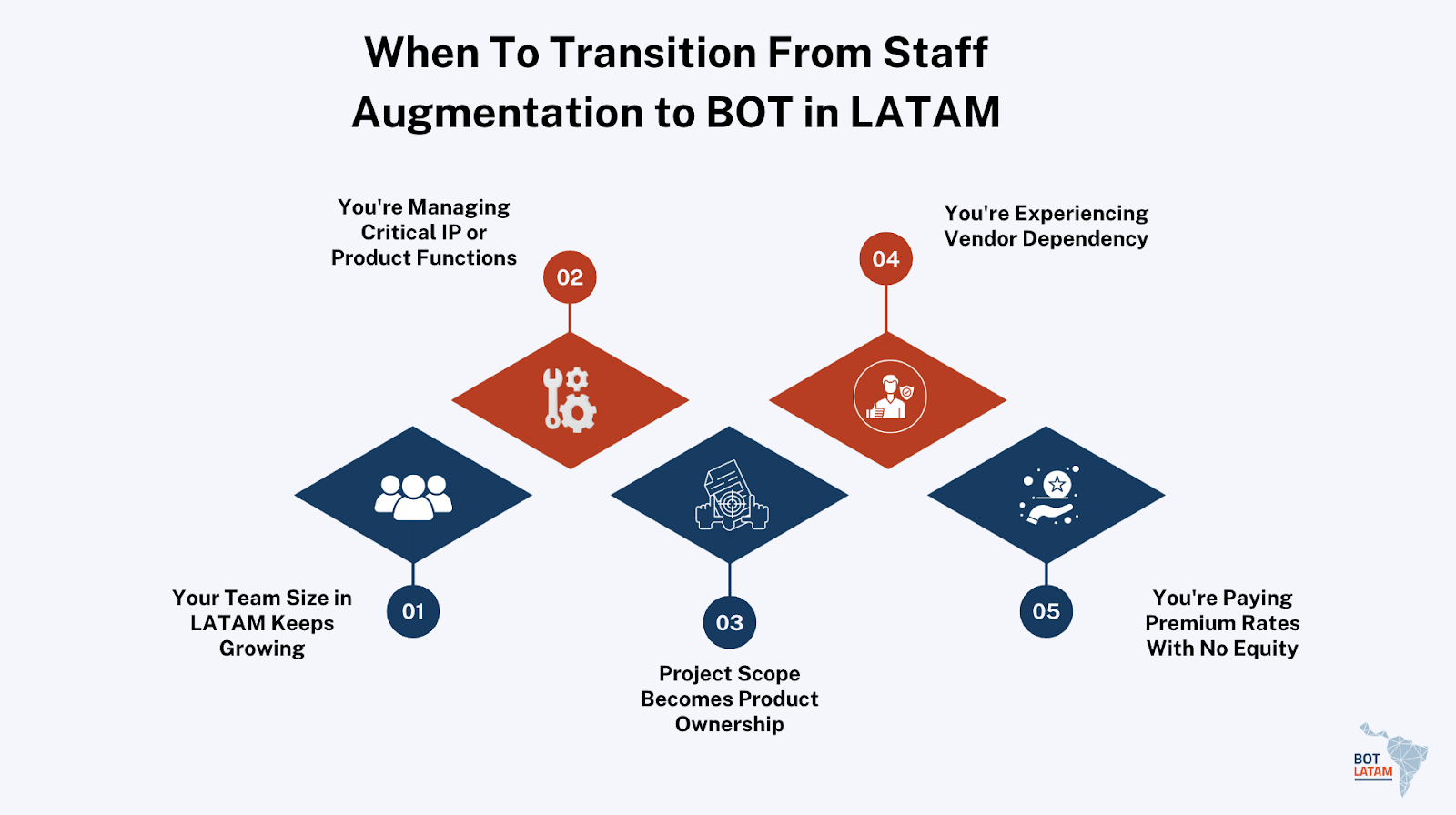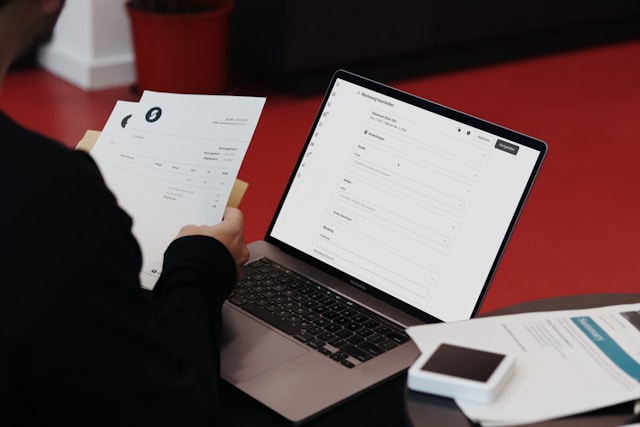If you're working with a LATAM-based augmented team and thinking long-term, there’s a moment when staff augmentation stops being enough. You need more control, more permanence, and a structure that scales. That’s where the Build-Operate-Transfer (BOT) model comes in.
This article walks through exactly when and why it makes sense to transition from staff augmentation to BOT. It breaks down the signs your business is ready to evolve, compares the two models side-by-side, and lays out a clear roadmap for making the switch.
Nearshore tech talent in LATAM has grown fast across Brazil, and Argentina now produce over 500,000 tech graduates each year, according to IDC. But if you want to turn that talent into a long-term asset, the model you choose matters. Keep reading to learn how to build a team you don’t just temporarily borrow, but eventually own.
Signs It’s Time To Move Beyond Staff Augmentation
1. Rising Costs Without Strategic Control:
Staff augmentation often begins as a flexible, low-risk way to scale your LATAM workforce. But over time, the hourly rates of top contractors can inch closer to what you’d pay for full-time staff, without giving you true ownership of the team or the output.
You’re still paying premium rates, yet you're not building internal capabilities or capturing long-term value. If you're pouring budget into augmented teams without gaining equity in infrastructure, process, or talent, it’s a red flag. According to Deloitte, 59% of companies using augmentation experience diminishing ROI after 18–24 months.
2. High Turnover and Lack of Cultural Integration:
One of the most common friction points with extended augmented teams is retention. Augmented staff often stay project-bound, leading to limited loyalty and shallow integration into your company culture.
When turnover becomes frequent or onboarding starts to feel endless, you’re spending more on continuity than innovation. If augmented developers aren’t aligned with your mission or product vision, you're not building team depth, you're buying capacity.
3. Limited Visibility Into Day-to-Day Operations:
As projects grow, transparency matters. With staff augmentation, you often rely on third-party management layers. That can lead to bottlenecks in communication, inconsistent performance, and little say in process improvement.
If your leadership team is asking for clearer reporting, tighter oversight, or more integration between teams, you’ve likely outgrown the augmentation model. The more strategic the project, the more critical visibility becomes.
4. Increasing Need for IP Security and Compliance:
Staff augmentation works best for tactical or compartmentalized workstreams. But when you're building core systems, handling sensitive customer data, or developing proprietary tools, security and compliance shift from being support tasks to business-critical functions.
If your LATAM team is contributing to source code or handling regulated data, continuing in a pure staff augmentation model introduces risk. The absence of localized governance frameworks and formal IP ownership can slow down certifications, audits, or even funding rounds.
5. Leadership Wants Ownership, Not Just Output:
At a certain point, business leaders stop asking, “Did the team ship the feature?” and start asking, “Are we building a self-sustaining product team?” That mindset shift is a key signal.
If your leadership is pushing for internal growth, operational maturity, or deeper alignment with product strategy, it's a sign that augmentation is holding you back. You need a model that lets you build, not borrow, your team.
In LATAM markets, where talent retention and cost efficiency are key competitive advantages, the transition to BOT helps you lock in these benefits while enhancing operational control.
How BOT Helps You Build a Long-Term LATAM Development Team
Transfers Ownership, Not Just Output.
The Build-Operate-Transfer (BOT) model gives you more than just deliverables, it gives you ownership. Once the initial “operate” phase ends, the team, tools, and processes become part of your internal infrastructure. That includes the physical assets, legal entity, employment contracts, and local management.
Unlike staff augmentation, where the relationship ends when the contract does, BOT establishes a permanent base for you in the region. You’re not just scaling, you’re embedding.
Enables Stable Talent Retention in Competitive LATAM Markets.
LATAM tech markets have become increasingly competitive. In Mexico and Brazil alone, demand for tech jobs has grown by over 30% year-over-year, according to Endeavor. With a BOT model, you offer full-time employment, local benefits, and long-term career paths, exactly what high-performing engineers are looking for.
Retention improves because your LATAM team isn’t treated as temporary labor. They're invested in your roadmap, not just their next project.
Builds Local Presence and Brand Equity.
Operating under your local entity (once the transfer is complete) gives your brand a real footprint in LATAM. That helps with employer branding, candidate trust, and long-term hiring pipelines.
Top engineers are more likely to join a company with local visibility, not just another outsourcing label. In markets like the ones in Colombia and Argentina, where top-tier tech talent often stays local, a branded local entity boosts recruiting power.
Aligns With Long-Term Strategic Planning.
BOT gives you room to grow into your LATAM operation, not just react to headcount needs. You can scale teams aligned with your product lifecycle, integrate global hiring strategies, and create a distributed yet unified culture.
It also supports broader planning around compliance, taxation, data sovereignty, and market expansion. You’re not limited to contractor bandwidth, you’re investing in capability.
In a region with deep technical talent and rising digital infrastructure, BOT helps you tap into the LATAM ecosystem in a way that staff augmentation can’t. It’s not about faster hires, it’s about smarter growth.
When To Transition From Staff Augmentation to BOT in LATAM

1. Your Team Size in LATAM Keeps Growing:
When your LATAM team surpasses a certain headcount, typically 25 to 50 full-time equivalents, it becomes more efficient to consolidate operations under a BOT structure. Managing dozens of augmented contractors across vendors can create overhead, compliance risk, and communication gaps.
At this scale, you're likely investing significant monthly spend without building long-term organizational value. According to Everest Group, companies that transitioned to BOT after reaching 40+ augmented engineers saw a 15–25% reduction in operating costs within 18 months.
2. You're Managing Critical IP or Product Functions:
If your augmented team is handling sensitive codebases, proprietary algorithms, or key infrastructure, staff augmentation may fall short on data governance and ownership protections. With BOT, you gain full control over IP, employment contracts, and security protocols, important for companies navigating audits, M&A, or market regulations.
This becomes especially relevant in finance, healthcare, and SaaS, where data compliance standards like SOC 2, ISO 27001, and HIPAA demand stricter control environments.
3. Project Scope Becomes Product Ownership:
Staff augmentation is useful for burst capacity or support functions. But when your LATAM team is no longer just contributing but owning features, running sprints, and deploying releases, the operating model needs to change.
If developers in Argentina or Colombia are now responsible for product roadmaps or managing local teams, it’s time to start building a structure that supports long-term alignment. BOT supports that evolution by formalizing the team under your leadership and brand.
4. You're Experiencing Vendor Dependency
The longer you rely on staff augmentation, the harder it becomes to untangle from third-party vendors. You may find yourself locked into service contracts, unable to adjust team composition or strategy without friction.
BOT reduces that reliance. Once transferred, your team operates independently with your processes, tools, and governance. That flexibility makes it easier to scale, pivot, or expand into new LATAM markets without renegotiating vendor terms.
5. You're Paying Premium Rates With No Equity:
When augmentation contracts start resembling long-term employment, but with none of the benefits, you’re losing ground. You're covering markups, renewals, and sometimes even recruiting fees, without gaining internal talent or regional infrastructure.
If your augmented engineers have been with you for 12+ months and are still technically external, it may be more cost-effective to start a BOT transition and bring them in-house under your entity. The ROI grows quickly once the “transfer” phase is complete.
Planning Your Transition Step By Step
Map Out the Full BOT Lifecycle:
Before committing to the BOT model, define what each phase, Build, Operate, and Transfer, will look like in your specific context. Set timelines, responsibilities, and success metrics for each phase.
The Build phase includes recruitment, infrastructure, and legal setup. Operate involves managing the team under the vendor’s supervision using your tools and workflows. Transfer shifts ownership to you. A typical lifecycle ranges from 18 to 36 months, depending on team size and maturity.
According to KPMG, 64% of BOT projects that fail to meet performance targets had no clear transition plan from day one.
Align Stakeholders Early:
You’ll need buy-in from multiple internal teams, legal, HR, finance, security, and engineering. If these groups aren’t aligned from the start, delays and compliance issues are likely.
Document internal policies on IP ownership, local hiring practices, and data handling. You’ll also want leadership aligned on KPIs, such as ramp-up timelines, budget allocation, and post-transfer productivity goals.
Establish regular check-ins across departments to maintain transparency throughout the transition.
Select a Vendor With Regional and Operational Expertise:
The BOT partner should have on-the-ground experience in your target LATAM country. Laws, labor codes, and tax structures vary widely between Brazil, Mexico, Argentina, and Colombia.
Look for a partner who understands entity formation, talent sourcing, and compliance, plus one that can localize employee benefits to improve retention. A McKinsey study found that companies working with vendors familiar with regional regulations were 2.5x more likely to complete successful BOT transitions on time.
Prepare Your Team for Cultural and Operational Integration:
Even before the transfer, treat your augmented LATAM team like a long-term unit. Use your internal tools, rituals, and communication channels from the start.
This early integration helps with knowledge transfer and reduces the culture shock that can occur after the formal transfer. Make sure training, onboarding, and documentation are shared from day one.
When it’s time to take full control, your team is already working as if they’re in-house, because in every practical sense, they already are.
Assess Legal and Financial Readiness:
The Transfer stage is not just symbolic, it involves compliance filings, payroll migration, IP assignment, and possibly setting up a local entity. Work with legal counsel to assess corporate structure options: subsidiary, branch office, or standalone entity.
Also consider double taxation treaties, social security obligations, and local labor laws. Countries like Uruguay and Chile offer tax incentives for foreign tech investment, while others have stricter reporting requirements.
Forecast cash flow for the transition phase to account for severance liabilities, employee benefit normalization, and administrative costs during handover. Strategic planning here prevents last-minute surprises.
Ready To Adopt The BOT Model?
Transitioning from staff augmentation to a BOT model isn’t just a structural change, it’s a strategic inflection point. When managed correctly, it allows your LATAM development team to become a true extension of your core business, not just a temporary solution.
At BOT LATAM, we specialize in helping US and global companies build, operate, and seamlessly transfer high-performing tech teams across Latin America. From entity setup to local compliance and IP transfer, our team brings operational depth and regional expertise. We've supported companies transitioning several roles across all of LATAM, improving retention rates post-transfer.
If your current model is no longer supporting your long-term goals, we can help you establish something permanent. Something built to scale. Contact us to schedule a free discovery call and start your own BOT project!

Revolutionize Your Workflow with Our Innovative BOT Strategy!
Enhance your operations seamlessly and adapt to market demands
Contact Us



%2017.26.38.png)
